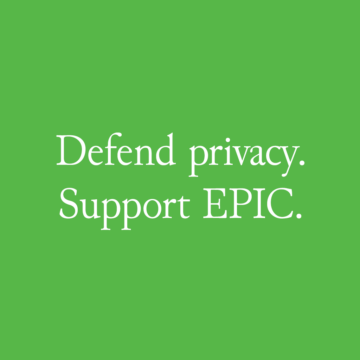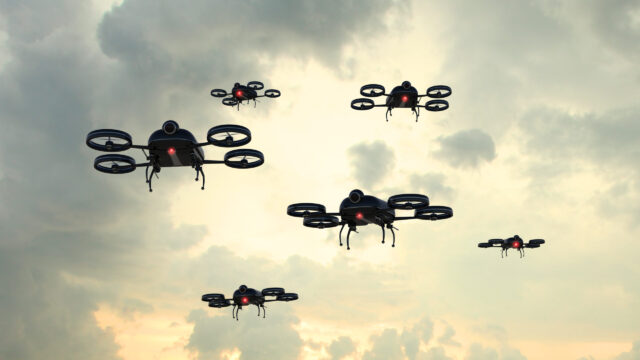Drones and Aerial Surveillance
Background
Surveillance from the skies threatens to end privacy in public, EPIC works to prevent that.
Documents
Manned surveillance aircraft and drones will allow the real-time monitoring of entire urban populations. Advances in camera technology and biometric recognition are now used by law enforcement to follow individuals across cities and in crowds. Corporate aerial surveillance is a growing field, and a growing privacy threat. EPIC opposes the use of mass, indiscriminate aerial surveillance.
Drones Lower the Bar for Aerial Surveillance
A drone is an aerial vehicle designed to be used without a human pilot onboard. Drones can be remote controlled or fully automated. A few factors make drones a serious threat to privacy:
- Drones greatly reduce the cost of aerial surveillance;
- Drones make aerial surveillance easy for anyone to do;
- Drones can be equipped with numerous types of surveillance technology;
- There are not well-established privacy protections to prevent widespread aerial surveillance.
Drones Make Aerial Surveillance Cheap and Easy:
Drones are far cheaper to use for aerial surveillance than traditional crewed aircrafts. Not only is a drone generally cheaper than a plane, a drone does not require an expensive certified pilot to operate. Professional-level drones with high-end cameras can be had for a few $1000s, while even drones well under a $1000 often can take high quality pictures and video. The cost of drones make widespread aerial surveillance possible.
Not only can more people afford drones, more people can fly drones. You generally do not need a pilot licenses to fly a drone. Additionally, the ever-advancing technology on drones make them easier and easier to fly. Even on relatively cheap drones, the technology can do a lot of the work to keep drones stable in the air and from crashing into objects. Some drones are capable of flying fully autonomously.
Drones Can Carry Various Surveillance Technologies:
Surveillance drones can be equipped with sophisticated imaging technology that provides the ability to obtain detailed photographs of terrain, people, homes, and even small objects. Drones regularly carry high-resolution cameras, infrared cameras, heat sensors, GPS, sensors that detect movement, and automated license plate readers. These cameras may include facial recognition technology that would make it possible to remotely identify individuals from a distance without their knowledge.
Aerial Surveillance is Largely Unregulated
In 2012 Congress mandated the Federal Aviation Administration integrate drones into the National Airspace, yet there are still no clear rules protecting individual privacy against drone surveillance. Despite the fact that drone surveillance implicates significant, First Amendment and Fourth Amendment interests and common law privacy rights, the law around conducting aerial surveillance very much remains in a gray area. This is particularly true for companies or individuals that might use drones for aerial surveillance since they are not subject to the First and Fourth amendment like the government. Without specific, enforceable rules, there will be the constant threat of drone surveillance every time you step outside.
Mass Surveillance by Aircraft
Crewed aircraft have already been used to conduct indiscriminate, wide-area surveillance of American cities. The camera technology to conduct such broad aerial surveillance was developed for large military surveillance drones used in the Afghanistan and Iraq wars. Persistent Surveillance Systems, U.S. company, added the surveillance camera technology to crewed aircrafts to offer aerial surveillance as a service.
In 2016 and for 6 months in 2020, the city of Baltimore ran an aerial surveillance pilot programimplemented by Persistent Surveillance Systems (PSS), recording roughly 90 percent of the city via high-def video cameras. The footage was stored and used to track cars as they moved through the city. PSS provided Baltimore police with software that combined their aerial surveillance footage with the city’s automated license plate readers, security camera footage, and “Shot Spotter” gunshot detection. PSS’s surveillance by aircraft created a searchable historical record of travel in Baltimore.
The Fourth Circuit ruled that Baltimore’s program violated Fourth Amendment because it “enables police to deduce from the whole of individuals’ movements[.]” EPIC joined an amicus brief arguing that under Carpenter v. United States the Baltimore Police Department’s ability to track individuals with at least 45 days of flight video augmented by automated license plate reader systems constituted a search. Despite the ruling by the Fourth Circuit, the law around aerial surveillance remains ill-defined.
Aerial Surveillance Must be Regulated
The integration of drones into the National Airspace requires new regulation to protect people’s privacy against aerial surveillance. Although drones pose the main threat to privacy from aerial surveillance, any new regulations should apply to crewed aircraft where applicable. The following elements should be included in the overall framework for regulating drones and aerial surveillance in general:
- Drone ID requirement to broadcast the identity and location of the drone along with details of the drones’ purpose, technical capabilities, and the government or commercial operator if applicable;
- A prohibition against generalized aerial surveillance by the government or government contractors;
- A warrant requirement for government drone surveillance;
- Restrictions on commercial data collection; and
- Transparency requirements for government and commercial operators.
A drone ID requirement is particularly important because it is one of the best means for the public to know in real-time when drones are in their proximity and provides a means to identify drones. Identification is necessary for transparency and accountability.
A Drone ID requirement should include:
- A requirement for drones to broadcast its identity and location in real-time;
- A specific and easily accessible means for the public to obtain the broadcast ID information of drones in their vicinity in real-time (e.g. an app on a smartphone); and
- A requirement that the surveillance capabilities, details of the drone’s purpose, and who is the operator (if government or commercial operator) be broadcast with the Drone ID or easily looked up via the Drone ID.
EPIC’s Work
EPIC was the first privacy organization to identify and oppose the threat of drone surveillance. Today EPIC is engaged on a variety of fronts to shape drone policy, prevent and roll back aerial surveillance programs, and address the growing dangers of corporate drone use. EPIC regularly comments on proposed rulemakings by the FAA and FCC that would regulate or expand the use of drones. EPIC also advocates for foregrounding privacy protections in the rollout of drones by serving on government advisory boards.
In the past EPIC has fought for transparency in government/industry drone policy planning projects and used the Freedom of Information Act to uncover government use of drones. EPIC was one of the first organizations to call for a requirement that drones broadcast an identification and spent years urging the FAA to implement one. The FAA is now in the process of implementing a remote ID requirement and EPIC will continue to push the FAA to make the requirement one that is useful in protecting the public’s privacy.
Recent Documents on Drones and Aerial Surveillance
-
APA Comments
EPIC Comments to the PCLOB on Domestic Terrorism
Top Updates
Resources
-
Current Unmanned Aircraft State Law Landscape
National Conference of State Legislatures | 2021
-
Drone Surveillance: The FAA’s Obligation to Respond to the Privacy Risks
Jeramie Scott | 2017
-
Drone Federalism, Civilian Drones and the Things They Carry
Margot Kaminski | 2013

Support Our Work
EPIC's work is funded by the support of individuals like you, who help us to continue to protect privacy, open government, and democratic values in the information age.
Donate